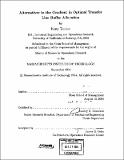Alternatives to the gradient in optimal transfer line buffer allocation
Author(s)
Tanizar, Ketty, 1978-
DownloadFull printable version (3.852Mb)
Other Contributors
Massachusetts Institute of Technology. Operations Research Center.
Advisor
Stanley B. Gershwin.
Terms of use
Metadata
Show full item recordAbstract
This thesis describes several directions to replace the gradient in James Schor's gradient algorithm to solve the dual problem. The alternative directions are: the variance and standard deviation of buffer levels, the deviation of the average buffer level from half-full, the difference between probability of starvation and blocking, and the difference between the production rate upstream and downstream of a buffer. The objective of the new algorithms is to achieve the final production rate of the dual problem faster than the gradient. The decomposition method is used to evaluate the production rates and average buffer levels. We find that the new algorithms work better in lines with no bottlenecks. The variance and standard deviation algorithms work very well in most cases. We also include an algorithm to generate realistic line parameters. This algorithm generate realistic line parameters based on realistic constraints set on them. This algorithm does not involve filtering and is fast and reliable.
Description
Thesis (S.M.)--Massachusetts Institute of Technology, Sloan School of Management, Operations Research Center, 2004. Includes bibliographical references (p. 113-114).
Date issued
2004Department
Massachusetts Institute of Technology. Operations Research Center; Sloan School of ManagementPublisher
Massachusetts Institute of Technology
Keywords
Operations Research Center.